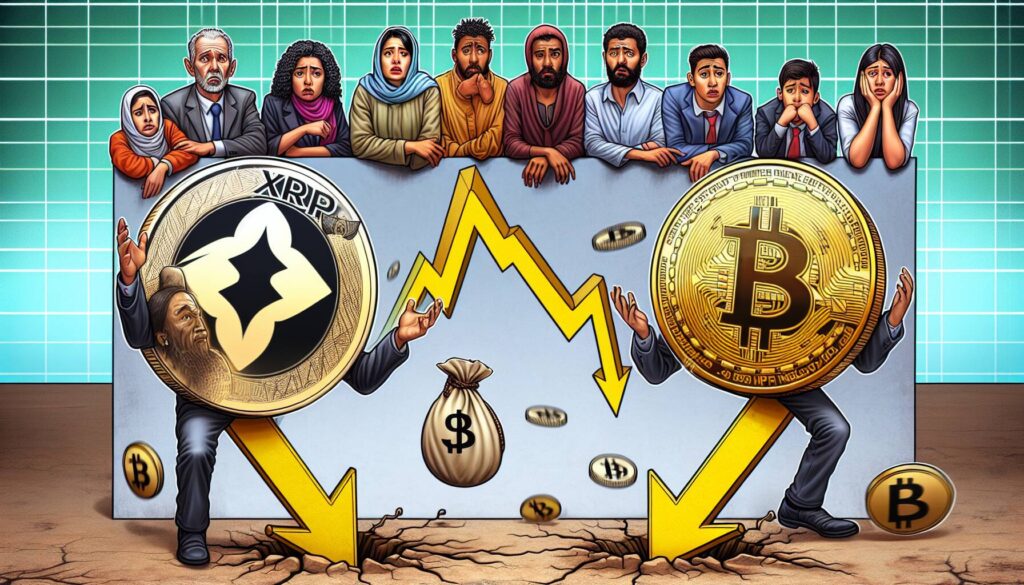In the ever-fluctuating cryptocurrency market, Bitcoin has recently taken a significant dip, sliding to $115,500, as macroeconomic data continues to cast a shadow over investor sentiment. This downturn has not only affected Bitcoin but has also seen notable declines in other major digital assets, including XRP, highlighting a broader trend impacting the crypto landscape.
The current economic environment is marked by inflation concerns, leading to swift market reactions. In a striking example, $420 million was wiped out in just 20 minutes, showcasing the volatility that cryptocurrencies exhibit under shifting economic indicators.
As various cryptocurrencies feel the pressure, the market shows signs of cautiousness, especially with news from notable companies like MSTR, BMNR, and SBET, which have seen steep declines amid cooling rallies in Bitcoin, Ethereum, and Solana. Conversely, the market has also had its moments of optimism, as exemplified by instances where Bitcoin reached record highs as investors leaned towards riskier assets during more favorable conditions. However, the current scenario reflects the challenges that persist, keeping traders and investors on high alert as they navigate this complex landscape.

Bitcoin Market Volatility and Its Implications
Key points regarding the current state of Bitcoin and the broader cryptocurrency market:
- Bitcoin’s Price Decline: Bitcoin has slid to $115,500, reflecting negative sentiment driven by macroeconomic data.
- Impact of Inflation Data: A recent inflation shock resulted in $420 million being wiped out within 20 minutes, highlighting the volatility and sensitivity of cryptocurrencies to economic indicators.
- Other Cryptocurrencies Struggle: XRP and other cryptocurrencies are also experiencing declines, contributing to overall market uncertainty.
- Treasury News: Notable companies like MSTR, BMNR, and SBET have seen plunging values, emphasizing the interconnectedness of corporate performance and cryptocurrency markets.
- Recent Rally Cooling: While Bitcoin and Ethereum had seen rallies, the current cooling in their market performance raises concerns about the sustainability of these gains.
- Investor Behavior: The rising interest in riskier assets suggests a shift in investor sentiment, which could lead to further fluctuations in the crypto market.
The trends and changes in the cryptocurrency market can significantly influence investment strategies and financial decisions for individual investors and institutions alike.
Bitcoin’s Decline Amidst Economic Uncertainty: A Comparative Outlook
The recent downturn in Bitcoin’s value to $115,500 has sparked significant attention, particularly as broader macroeconomic indicators contribute to a more hesitant market atmosphere. Market sentiment is undeniably affected by rising inflation rates, which have created a ripple effect across the cryptocurrency space, dragging down not just Bitcoin but also prominent players like XRP and Ethereum. This situation presents a complex landscape for investors, characterized by heightened volatility.
On one hand, the decline presents a cautionary tale for potential investors, signaling a time for prudent decision-making and risk assessment. Investors grappling with the challenges posed by such macroeconomic data are likely to be more discerning about their entry points into the market, which could lead to a temporary setback in trading volumes and liquidity. Moreover, those with significant holdings in cryptocurrencies might find themselves experiencing increased anxiety as fear grips the market.
Conversely, the downturn also creates potential opportunities for savvy investors willing to capitalize on lower asset prices. For instance, the recent slide could serve as an attractive entry point for those looking to invest long-term in cryptocurrencies, particularly if they believe in a market rebound. However, this approach could backfire if inflationary pressures continue to mount, leading to further declines in asset values.
Moreover, the competitive landscape encompasses other digital currencies and financial instruments that may either cushion the fall or exacerbate the risks associated with investing in fluctuating assets like Bitcoin, Ethereum, and Solana. Investors should weigh these dynamics carefully, considering whether to remain in the crypto space or pivot to more stable investment avenues as macroeconomic conditions evolve. Understanding who these shifts could benefit or harm is crucial in navigating this tumultuous market.

















